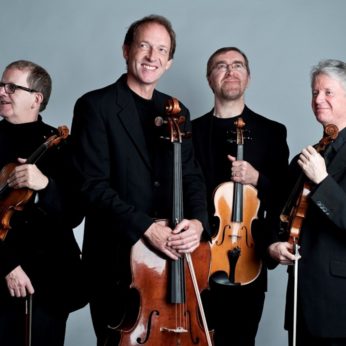Composer: Wolfgang Amadeus Mozart (b. 1756 - d. 1791)
Performance date: 29/06/2012
Venue: Bantry Library
Composition Year: 1789
Duration: 00:24:37
Recording Engineer: Anton Timoney, RTÉ lyric fm
Instrumentation: 2vn, va, vc
Instrumentation Category:String Quartet
Artists:
RTÉ Vanbrugh Quartet (Gregory Ellis, Keith Pascoe [violins], Simon Aspell [viola], Christopher Marwood [cello]) -
[quartet]

The years 1789-91 saw many dramatic changes in Mozart’s life. Austria’s war with Turkey was bleeding Vienna. Much of the nobility was involved in the army and others left Vienna for their country estates. The large orchestras of the nobility were disbanded and subscription concert series were abandoned for lack of support. In Mozart’s life bourgeois society and the Schikaneder theatre were to replace the aristocratic salon and the court opera. Mozart’s only court appointment required him to compose large quantities of dance music for the court balls given in the Imperial palace at Carnival time. In his endless search for money he would sell piano transcriptions of these dances to the publisher Artaria. It should be remembered that in the absence of copyright law, Mozart earned nothing from his huge success all over Europe. So apart from the Imperial commission for Cosi, Mozart had to turn his attention from concertos and symphonies to smaller scale works.
Thus the Spring of 1789 saw Mozart travelling to Berlin and Potsdam to meet the cello playing King Friedrich Wilhelm II of Prussia in the hopes of either a commission or a remunerative post. Given Mozart’s absolute determination not to compromise his independence and the fact that Austria and Prussia were recently at war, the latter option was always unlikely though it seems a serious offer was made. He was however given a commission to compose a series of quartets and sonatas, which he began on the way home. The D major Quartet was actually written on paper he bought in Bohemia on his journey back to Vienna. Unfortunately it would appear that there was a deadline on the completion of the commission, which Mozart was unable to meet despite strenuous efforts the following summer, and he ended up selling the three so-called Prussian Quartets to the publisher Artaria.
The first two movements of this strange Quartet are comparatively straightforward by Mozart’s standards. However the actual sonority of the quartet is very new; it is not just the extensive role the cello plays, the music seems to inhabit another dimension especially the first subject and the B minor opening of the development. The Andante in A-major is in simple ternary form with no surprising modulations. It has that simple, unassuming beauty that Mozart so excelled at and the cellist king gets his share of the limelight. The Menuetto is in the usual binary form with repeats; the first half has nothing unexpected but the second half drops the polite mask with some searing chords and brutal tonal shifts. The Trio is miraculous with the cello getting the delicious cantilena solo part at the beginning before handing it to the others taking care to integrate the cello soloist, however royal, into his quartet.
The Finale returns to the sound-world of the first movement but with a much more adventurous structure, a kind of modified sonata form. The main theme, in the cello again, is clearly related to the first movement. It is later accompanied by a counter melody in descending triplets that is made much of in the development sections. In place of a second subject the first returns at the second violin with new accompaniments and is followed out of nowhere by a beguiling new theme. The development concentrates on the triplet counter melody and travels through more modulations and dissonances than in the rest of the work. Clearly the cellist King had to be shown that good music can be complex as well as beautiful, challenging as well as melodic.
Copyright © 2025 West Cork Music. All rights reserved.
Designed and developed by Matrix Internet